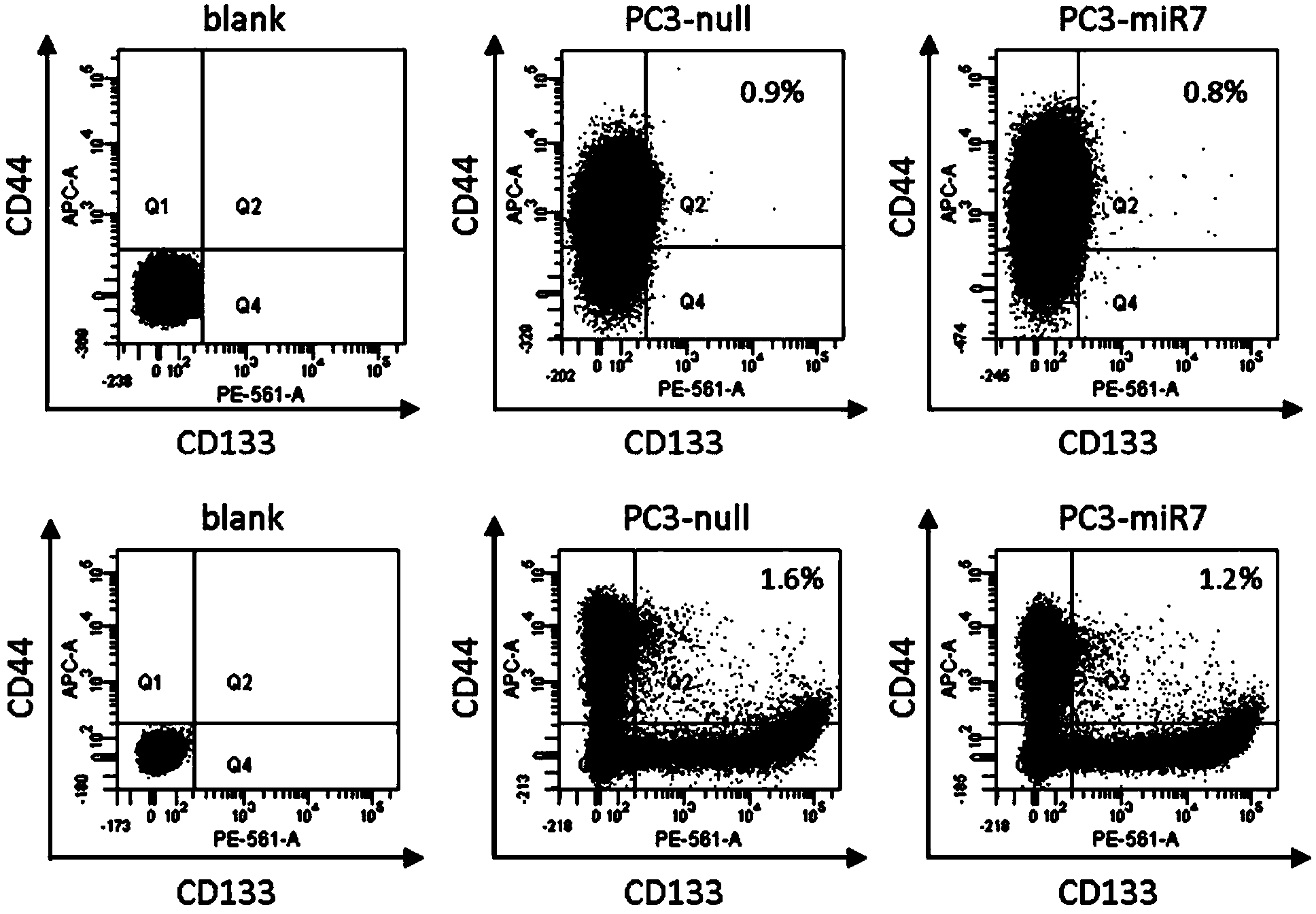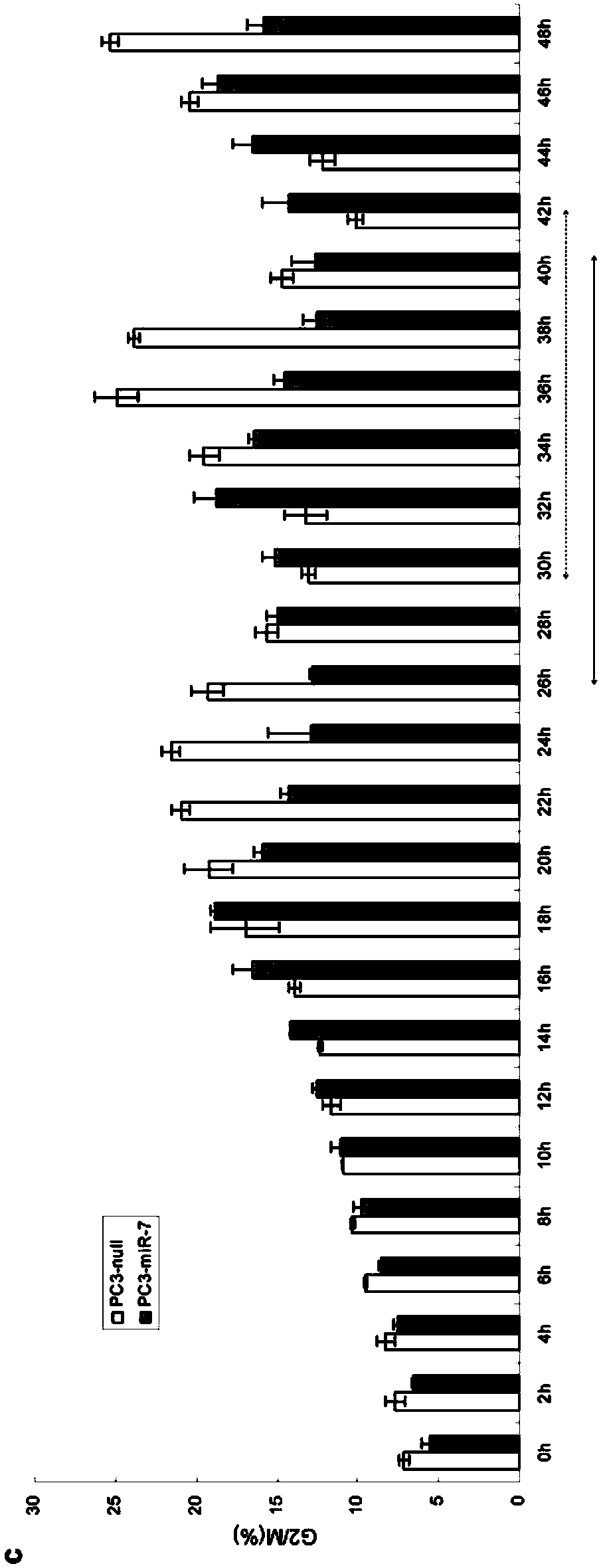Application of microRNA-7 for inhibiting prostate tumor growth and prostate tumor progress
A technology for prostate tumor and process, applied in the field of microRNA, can solve problems such as unclear mechanism of action, achieve the effect of inhibiting proliferation ability, broad application prospects, and promoting nuclear entry
- Summary
- Abstract
- Description
- Claims
- Application Information
AI Technical Summary
Problems solved by technology
Method used
Image
Examples
Embodiment 1
[0030] Using the dual luciferase reporter system to identify the interaction between miRNA and target gene mRNA 3'UTR: PC3 cells (purchased from the Cell Bank of Chinese Academy of Sciences, as an example, but not limited to this) were completely cultured in DMEM in a 24-well plate Cell culture medium (containing 10% fetal bovine serum, purchased from Gibco, USA) was adhered to the wall, and when the cell density reached 70% to 80%, use lipofectamine2000 transfection reagent (purchased from Life Technology, USA) to perform the following operations: 1) take Cells in 3 wells were used as a parallel sample, and the positive control reporter vector (the positive control here is a sequence that is completely complementary to miR-7, i.e. sequence 4) and the internal reference vector pRL-cmv expressing the Renilla luciferase gene (purchased In the United States promega company) and control scramble RNA (purchased in the United States Life Technology company, the data see figure 1 Whi...
Embodiment 2
[0032] (1) Construction of an expression vector for stably expressing miRNA in eukaryotic cells: with the pEGP-miR plasmid as the backbone (purchased from Cell BioLab, USA), the plasmid was linearized by conventional restriction endonuclease BamHI / NheI double digestion. change. By artificially synthesizing the desired miRNA precursor molecule sequence (here three different precursor molecules pri-miR-7-1, pri-miR-7-2 and pri-miR-7-3 of miR-7 are taken as examples , but not limited to this, see sequence 1, 2, 3), and introduce restriction enzymes BamHI and NheI (also can be XbaI, which is the same tail enzyme of NheI) at the 5' end and 3' end of the sequence respectively recognition site. The obtained fragment is subjected to conventional restriction endonuclease BamHI / NheI (also BamHI / XbaI) double digestion, and conventional DNA ligation operations to construct an expression vector for eukaryotic cells to stably express miRNA (herein pEGP -miR-7-1, pEGP-miR-7-2, and pEGP-miR...
Embodiment 3
[0036] Stable overexpression of miR-7 can achieve cell cycle arrest in prostate cancer cell lines (take PC3-miR-7 cells as an example, but not limited to): Pass PC3-miR-7 and control PC3-null through conventional cell lines The culture method is adherent culture in a 12-well plate, and each type of cell needs to repeat 3 replicate wells at each time point of detection. In this embodiment, the ratio of cell numbers in each cell phase (G0 / G1 phase, S phase, G2 / M phase) was detected every 2 hours, and the detection was continued for 48 hours, with a total of 24 time points. When the cell density reaches 60%-70%, the complete medium is replaced with serum-free basic medium, and the cell cycle is synchronized to the G0 phase through serum starvation for 30-36 hours, and is in a resting state. The detection starts after the serum supply is restored, and the starting point of the serum supply is 0 hour, and the time is sequentially counted. At the detection time point, use the conve...
PUM
 Login to View More
Login to View More Abstract
Description
Claims
Application Information
 Login to View More
Login to View More - R&D
- Intellectual Property
- Life Sciences
- Materials
- Tech Scout
- Unparalleled Data Quality
- Higher Quality Content
- 60% Fewer Hallucinations
Browse by: Latest US Patents, China's latest patents, Technical Efficacy Thesaurus, Application Domain, Technology Topic, Popular Technical Reports.
© 2025 PatSnap. All rights reserved.Legal|Privacy policy|Modern Slavery Act Transparency Statement|Sitemap|About US| Contact US: help@patsnap.com



